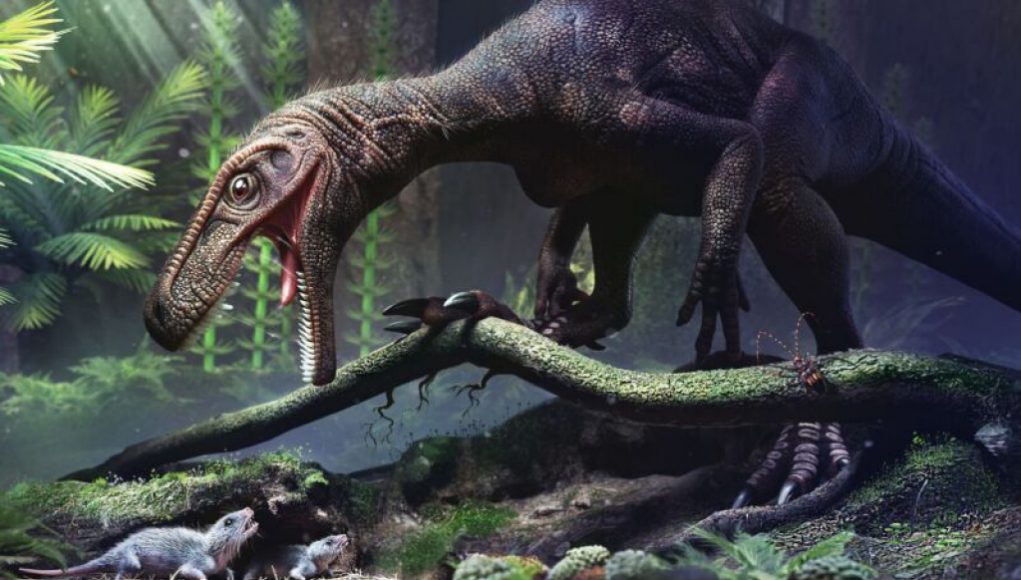Somewhere in Earth’s past, some branches on the tree of life adopted a body plan that revolutionized breathing and cooling down. This development played a crucial role in the evolution of some of the largest dinosaurs to ever roam the planet. It was so successful that it persisted in three different groups of extinct species and continues to exist in the living descendants of dinosaurs.
But how do scientists study the breathing capabilities of these ancient creatures when lungs don’t usually fossilize? The answer lies within their bones.
In a series of groundbreaking papers published in late 2022 and early 2023, paleontologists examined the fossil microstructure of some of the earliest known dinosaurs to uncover the evolution of their respiratory system.
Breathing efficiency
In species like birds, the respiratory system includes air sacs within bones throughout the body. Unlike mammals, who inhale and exhale separately, these air sacs enable unidirectional breathing, allowing for efficient oxygen intake and heat extraction. This system, known as postcranial skeletal pneumaticity, is exclusive to birds today. While crocodilians also have unidirectional breathing, their bones lack air sac cavities. A study from 2012 confirmed the absence of postcranial skeletal pneumaticity in crocodile-line archosaurs.
Advertisement
“There are no anatomical signs of any true pneumatic features that would have been related to invasive air sacs prior to the evolution of pterosaurs and saurischian dinosaurs,” explained Tito Aureliano, a paleontologist at Brazil’s Universidade Federal do Rio Grande do Norte.
Aureliano, the lead author of the recent papers, highlighted the advantages of an invasive air sac system. Unlike mammals, who can become breathless or overheated during intense physical activity or heat exposure, creatures with air sacs can avoid these issues.
So when did these air sacs first appear? They were already present in Cretaceous theropods, pterosaurs, and sauropods, which lived approximately 145 to 66 million years ago. To trace their origin, the research team delved further back into the Triassic period (about 252 to 201 million years ago). They studied two types of sauropodomorphs and a carnivorous dinosaur named Gnathovorax.
“The big question was,” Aureliano explained, “did the common ancestor of these three groups in the Triassic already have air sacs, or did the air sacs evolve independently three times?”
Multiple origins
If fossil bone tissue showed traces similar to those found in modern birds, it would indicate the presence of this respiratory adaptation. However, none of the early species exhibited these traces, suggesting that postcranial skeletal pneumaticity had not yet evolved. This means it couldn’t have been present in the common ancestor of dinosaurs and other major groups where it was also found.
Advertisement
This discovery surprised co-author Aline Ghilardi, a paleontologist and tenured assistant professor. She noted that since the earliest dinosaurs lacked invasive pneumatic structures, the air sacs must have evolved later. This implies that pterosaurs also independently evolved this respiratory system.
Furthermore, the fossils indicated that the evolution of air sacs had already begun during the Triassic period. The sauropodomorphs and herrerasaurid studied lived approximately 233 million years ago. However, Pampadromaeus, which existed slightly later than Buriolestes, showed a significant change in its skeleton. It had a new type of tissue that may have been a precursor to air sac evolution.
“The whole vasculature was different [in Pampadromaeus],” Aureliano explained. “It was less dense and had fractals inside, small chambers for blood and fat tissues.” This unique structure may have paved the way for future invasive air sacs to occupy the space created by those fractals, as air sacs function similarly to fractals extending from the lungs.
Today, a new study published in Nature Communications unveils an intriguing evolutionary detail in the dinosaurs’ anatomy: Dinosaurs’ breathing can be traced back to an early adaptation of a bone-based breathing system used by bipedal archosaurs, the earliest forerunners of dinosaurs, about 250 million years ago.
The study describes how, when dinosaurs split from other species within the Archosauria group almost 240 million years ago, they underwent dramatic changes in their breathing anatomy and lifestyle.
The team of paleontologists from the China University of Geosciences in Beijing studied the evolutionary history of dinosaurs by analyzing fossilized specimens from various species including the troodontid Microraptor zhaoianus, theropod Allosaurus fragilis, prosauropod Plateosaurus engelhardti, and the Late Triassic archosaur Nyasasaurus parringtoni.
Using 3D modeling technology and micro-CT scans, the researchers discovered that the earliest dinosaurs had a type of breathing system similar to what is seen in modern birds, a bone-based breathing system that involves the motion of raptorial ribs. This suggests that the evolution of dinosaurs was closely linked to the evolution of their breathing anatomy and that their flight capabilities were the consequence of these anatomical modifications.
In addition, the scientists found that the dinosaurs’ breathing system evolved independently from other archosaurs in the same period. This means that dinosaur breathing was an adaptation to their lifestyle and enabled them to move efficiently over land, thus aiding their successful diversification and diversified habits.
The findings of this study provide a fascinating insight into the evolution of dinosaurs and the evolution of bipedal locomotion. This research offers important information about the anatomy and behavior of these animals that lived millions of years ago and shows us how they adapted to new environments and transformed themselves over time to become the dominant dinosaurs we know today. It also offers a more in-depth understanding of the origin of some of the most iconic dinosaur groups.




















